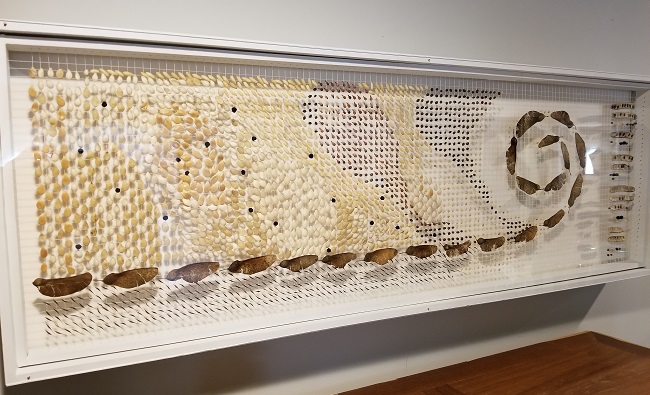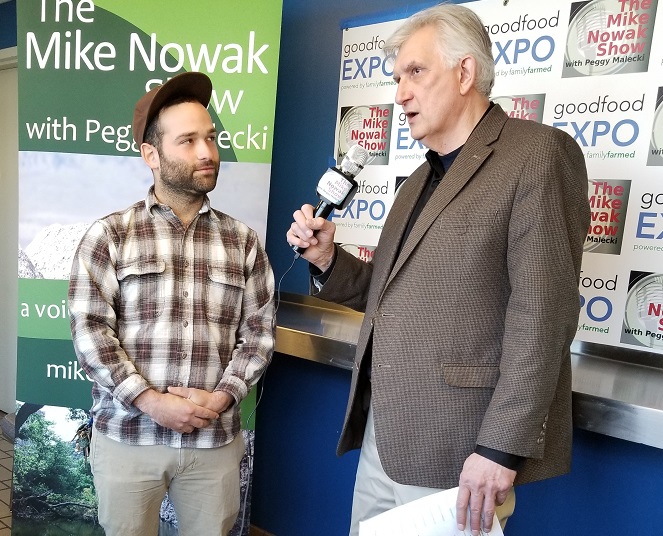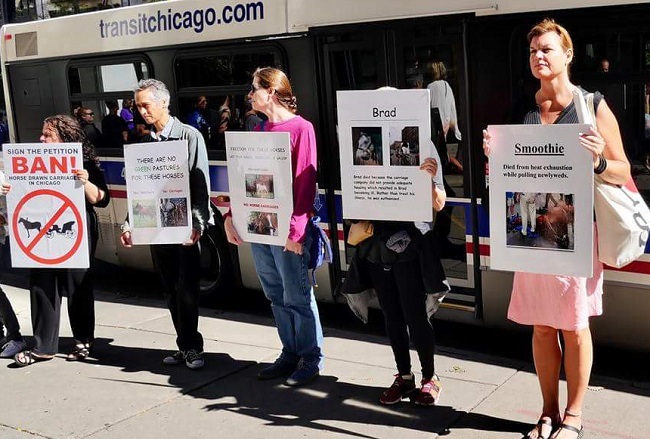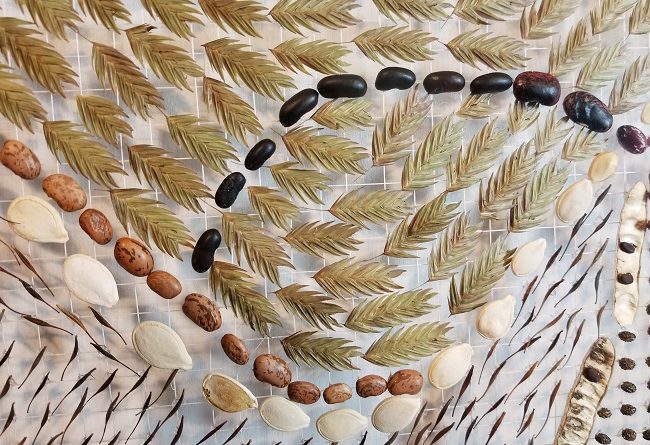Seeds As Art, Seeds As Medium
Podcast: Play in new window | Download (Duration: 1:44:34 — 47.9MB)
Subscribe: Apple Podcasts | Spotify | Android | iHeartRadio | Podchaser | Email | TuneIn | RSS | More
(April 1, 2018) I first met artist Shilin Hora in what seems another lifetime. It was 2015 I was doing podcasts on my dining room table. I received an email from Shilin about a group called Proviso Partners for Health, which I documented in a podcast on August 30, 2015 about their Raise the Hoop Garden Festival. Some of those partners were Proviso East High School, Triton College, University of Illinois Extension: Cook County, Reuse Depot, Quinn Community Center, Mander Foundation, and a bunch more, who had come together to teach young people about healthy eating, entrepreneurship and self-sufficiency at the Giving Garden in Maywood, Illinois.
What I liked about Shilin was that she didn’t seem to be personally getting anything out of working with me to cover the event. What I later discovered was that she was an artist who used plant seeds as one of her media. So when she contacted me recently to view some of her art, which she calls her “Seed Museum works,” I was intrigued, and felt that I owed her a visit. This is how she describes them:
 Seed Museums are rare, one-of-a-kind nature-art objects created by Shilin Hora. The Museums are wall art in which seeds are dried and artistically exhibited emphasizing their exquisite designs. The Seed Museums are inspired by the 19th century Wardian cases that exploring botanists used to import foreign plants to Europe from overseas. The wall hanging Museums are an exquisite blend between natural history specimen collection and fine art museum display, meant to inspire the Explorer in all of us.
Seed Museums are rare, one-of-a-kind nature-art objects created by Shilin Hora. The Museums are wall art in which seeds are dried and artistically exhibited emphasizing their exquisite designs. The Seed Museums are inspired by the 19th century Wardian cases that exploring botanists used to import foreign plants to Europe from overseas. The wall hanging Museums are an exquisite blend between natural history specimen collection and fine art museum display, meant to inspire the Explorer in all of us.
I was not disappointed. Check out the photo of the shadow box on the right. That’s one of the pieces that were displayed in Hora’s studio.
You can see more here.
Shilin Hora joins us in studio this morning to discuss her art.
Meet the Good Food EXPO Farmer of the Year
At this year’s Good Food EXPO, Peggy and I spent most of Friday interviewing a lot of movers and shakers in the good and healthy food movement on Facebook live. One of those interviews Yoram Shanan of Sandbox Organics, who was the recipient of the 2018 Beginning Farmer of the Year award.
 At the time, we made him promise that he would be part of our Easter show, if only because we knew that it was going to be difficult to get guests to commit to the program on a holiday. (Hey, we’re nothing if not transparent!) Yoram is part of a new, though small, wave of young farmers in the United States that was profiled in this article in the Washington Post.
At the time, we made him promise that he would be part of our Easter show, if only because we knew that it was going to be difficult to get guests to commit to the program on a holiday. (Hey, we’re nothing if not transparent!) Yoram is part of a new, though small, wave of young farmers in the United States that was profiled in this article in the Washington Post.
The number of farmers age 25 to 34 grew 2.2 percent between 2007 and 2012, according to the 2014 USDA census, a period when other groups of farmers — save the oldest — shrunk by double digits. In some states, such as California, Nebraska and South Dakota, the number of beginning farmers has grown by 20 percent or more.
A survey conducted by the National Young Farmers Coalition, an advocacy group, with Merrigan’s help shows that the majority of young farmers did not grow up in agricultural families.
They are also far more likely than the general farming population to grow organically, limit pesticide and fertilizer use, diversify their crops or animals, and be deeply involved in their local food systems via community supported agriculture (CSA) programs and farmers markets.
Interestingly, that article was debunked by this article in The New Food Economy:
Part of the reason the Post’s assertions on these matters are so at odds with the data is that the survey it relies on for many of its claims is, in the sponsoring organization’s own words, “not randomly selected nor statistically modeled to represent all young farmers.” The National Young Farmers Coalition (NYFC), a progressive organization, distributed the survey online and to coalition members and young farmers connected with 94 other organizations that work with or represent farmers. With few exceptions, the participating organizations work to build local or sustainable food systems. As a result, the survey was heavily skewed toward the “highly educated, ex-urban, first-time farmers” the Post purports to show are the future of farming. Just as we would expect a survey of College Republicans to report favorable views of Donald Trump among young people, so, too, would we expect a survey of farmers in local and sustainable food networks to report high rates of sustainable and local production among young farmers.
That article, in turn, was challenged by readers who took issue with the conclusions presented by The New Food Economy:
Where we disagree is whether or not this modern-day “back to the land” movement currently exists and at what scale it is occurring. There is ample evidence to support that it does, including the rapid rise of farmers’ markets, CSAs, farmer-owned cooperative distribution, farmer training groups, and the rise of the NYFC itself, a vibrant and growing advocacy group.
In reality, the farmers involved in this movement aren’t just “young and minority.” They are young and old, male and female, city- and rural-dwelling, LGBTQ and straight, and fairly racially diverse. What they largely have in common is a great desire to grow diversified products using organic production methods.
Perhaps Yorum, who belongs to both the National Young Farmers Coalition and a group called Chillinois Young Farmers, has something to say about that. We know that he will promote the upcoming 2nd Annual Fundraiser and Farmer Talent Show, presented by Chillinois Young Farmers and Band of Farmers. It happens at Begyle Brewery on April 7th. The event will be from 6pm to 10pm with performances starting at 7pm and hopefully going until about 830pm. You can even sign up to be part of the entertainment here!
The future of carriage horses in Chicago
If you live in Chicago or have ever visited the downtown area, you have undoubtedly seen the horse-drawn carriages that slowly make their way through traffic thick and thin. You might have purchased a ride from one of these businesses, or perhaps cursed being stuck behind a rig as you were running late to an appointment.
But have you ever stopped to think about the life of the horses that are required to work night and day in heat and cold, on unforgiving pavement, surrounded by pollution-spewing machines that are loud and dangerous?
 Jodie Wiederkehr has, and she doesn’t like what she sees. Jodie is campaign director for a group called Chicago Alliance for Animals (CAA). Its purpose is to work generally in the service of animal welfare. Lately, however, the group has been focused on putting horse-drawn carriages in Chicago out of business. Why? Simply put, Wiederkehr’s group claims that their practices are inhumane.
Jodie Wiederkehr has, and she doesn’t like what she sees. Jodie is campaign director for a group called Chicago Alliance for Animals (CAA). Its purpose is to work generally in the service of animal welfare. Lately, however, the group has been focused on putting horse-drawn carriages in Chicago out of business. Why? Simply put, Wiederkehr’s group claims that their practices are inhumane.
She recently sent a letter to Chicago’s aldermen, urging them to support ordinance O2017-8598, which is co-sponsored by Aldermen Brendan Reilly, Brian Hopkins and Raymond Lopez. The ordinance, which is currently sitting in the Committee on License and Consumer Protection, would prohibit the renewal of horse-drawn carriage licenses. She notes that in the first half of 2017 alone, CAA documented more than a hundred violations that could result in the issuance of more than $100,000 in fines.
In fact, the three Chicago horse-drawn carriage companies were to have appeared before a city administrative judge on March 28. That has been postponed until this week, and a lawyer representing the three companies has likened the violations to traffic tickets. How the judge views them remains to be seen.
Wiederkehr notes that the CAA has
documented horses forced to work 12 plus hour days (in blatant violation of the City’s 6 hour per 24 hour limit), working in oppressive heat and humidity in summer and bone chilling cold in winter. We’ve witnessed drivers routinely disregarding the laws that impact public safety such as being on their cellular phones while driving in traffic and being on streets at times when they are not allowed. The horses must also endure contempt by the drivers who were caught on video washing their hands in the horses’ drinking water and flicking their lit cigarette butts at the horses feet.
She and her group have a litany of other complaints against the industry:
- Horses may be stuck in cement barns and in suffocating stalls with no place to exercise
- 18th century horse carriages in a 21st century congested urban motorized environment is a real danger to the public
- The horse carriage companies admit their business model is to break the law
- The horse carriage companies repeatedly violate the law because city agency, business affairs & consumer protection (bacp) lacks the resources to enforce the law
The CAA isn’t the only group that would like to see urban horse-drawn carriages disappear. The Animal Welfare Institute also lays out a compelling argument for a ban. Weather is just one issue, albeit significant:
Carriage horses are exposed to a wide range of temperatures and humidity levels. In New York City, the regulations allow for their use pulling carriages whenever the temperature is between 18 and 90 degrees Fahrenheit (in Chicago, the minimum allowable temperature is 15° F). There are no regulations regarding humidity. Road conditions at the edges of the temperature range can be a serious issue. In hot weather, asphalt temperatures may be 50–100° F higher than the air temperature and can damage the sensitive areas of the hoof. The extreme heat also puts the horses at risk of dehydration and overheating. A typical horse will drink 5–10 gallons of water a day. Horses pulling carriages in high heat require much greater volumes (15–20 gallons), as they may lose over 10 gallons of water from evaporation. This much water is difficult to provide in the urban setting, even when water troughs are available. During high humidity days, the horses may be unable to properly cool themselves through sweating or other measures, putting them at further risk of overheating.
While the dangers of dehydration and overheating are reduced in cold weather, there are still problems. For example, salt-treated roadways are the same temperature as the air and can cause frostbite to the hoof.
Peggy and I welcome Jodie Wiederkehr to the WCGO studios on this Easter Sunday to discuss this animal welfare issue.


